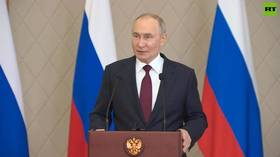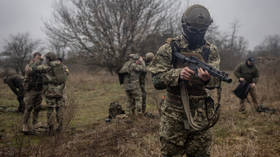Cruiser Aurora fires at Winter Palace 100 years ago, signals peak of Russian Revolution

The mighty Aurora battleship has fired a deafening warning shot, marking the climax of the October Revolution and the Bolshevik storm of the Winter Palace where members of Russia’s provisional government are holed up.
These events had happened exactly 100 years ago at 21:40 and signaled the culmination of the provisional government’s catastrophic loss of sway over the Russian nation.
FIRE!!! 🔥 #1917LIVE
— The Cruiser Aurora (@Aurora_1917) November 7, 2017
Vladimir Lenin had by then amassed a countrywide following of soldiers, sailors and the entire Russian working class. The capital, Petrograd, was theirs for the taking. RT and its #1917LIVE re-enactment project takes readers back 100 years, offering an opportunity to be in the heart of the action.
Forecastle gun locked & loaded with blank shot. Awaiting command to fire #1917LIVEpic.twitter.com/3pe9oN1wSu
— The Cruiser Aurora (@Aurora_1917) November 7, 2017
For two days now, the government has been summoning the city’s Junkers – the remaining loyal forces it would use to repel Lenin’s Red Guards and soldiers.
Lenin himself is now in Smolny – the Bolshevik headquarters, having returned to Petrograd under cover of night to coordinate the rebellion.
To work, comrades! Tonight will be historical! ✌️ #1917LIVE
— Vladimir Lenin (@VLenin_1917) 6 ноября 2017 г.
On the 6th, small battles played out over key crossings, government buildings and bridges of modern-day St.Petersburg. The Bolsheviks needed to control the city. The Aurora’s job the following day was to keep the Nikolayevsky Bridge down, keeping up an imposing presence on the Neva River. If the Bolsheviks fail to take the Winter Palace, its instructions are to shell it with everything it’s got.
HAPPENING NOW: Streets around Winter Palace teeming with @MRC_1917 Red Guards & heavy weaponry #1917LIVEpic.twitter.com/zDyDt2tBum
— Revolutionary Times (@RT_1917) November 7, 2017
Earlier on the 7th, the Military-Revolutionary Committee’s (MRC) ultimatum to the provisional government yielded no response; and the decision was taken to act. On the opposing side, in the absence of any concrete orders from the government, the Junkers stationed at the Palace had began abandoning their posts. Only a handful stayed behind to set up machine gun firing points to repel the Bolsheviks. By 9PM, major government buildings, as well as train terminals, were already taken by the Bolsheviks.
The forecastle cannon of the Aurora also signaled the arrival of five Baltic Fleet destroyers and a patrol boat, whilst the firefight at the Winter Palace was already underway.
BREAKING: NOW 100 years ago Cruiser Aurora fires at Winter Palace, signals Russian Revolution peak #1917LIVEhttps://t.co/WkrZx6oQ18pic.twitter.com/hVodR0Uqmf
— RT (@RT_com) November 7, 2017
Kerensky, having earlier left the capital to summon frontline troops, was nowhere to be seen. The government was using all available phone lines it still controled to connect to the outside.
Later that evening, Lenin would deliver a historic speech at the Congress of the Soviets, and by nightfall of the 7th, all state power would officially pass into the hands of the Soviets. Their first orders of business will be maintaining revolutionary order in Russia and a fair peace on the front lines. The next task is resolving the food and land issues, and guaranteeing a timely Constituent Assembly.
By 11pm, the Winter Palace was still be under siege, with the Aurora menacingly standing watch with floodlights trained on the building. However, before the clock struck midnight, the Junkers, as well as the female death squad volunteers tasked with guarding the government, had been overwhelmed. The Revolutionary Red Guards then entered the palace to search for members of the provisional government. They were hunted down and placed under arrest before long.












